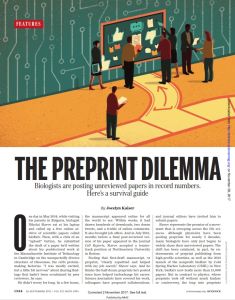Join getAbstract to access the summary!

Join getAbstract to access the summary!
Jocelyn Kaiser
The Preprint Dilemma
Biologists are posting unreviewed papers in record numbers. Here’s a survival guide
Science, 2017
What's inside?
Preprints without peer reviews offer researchers benefits, but not everyone is convinced of their value.
Recommendation
Preprint publishing is the sharing of manuscripts not yet reviewed by peers. The practice has gained support from major institutes, funding sources and leading researchers. As a result, preprints are now increasingly popular among biologists. Still, not everyone is convinced about the idea. Science staff writer Jocelyn Kaiser lays out some potential benefits and drawbacks of preprints. She highlights these points with views from current researchers. The article will serve as a guide for science enthusiasts curious about sharing research through preprints.
Summary
About the Author
Jocelyn Kaiser is a staff writer for Science. She has covered stories ranging from environmental science to biomedical research policy and the National Institutes of Health.

















Comment on this summary